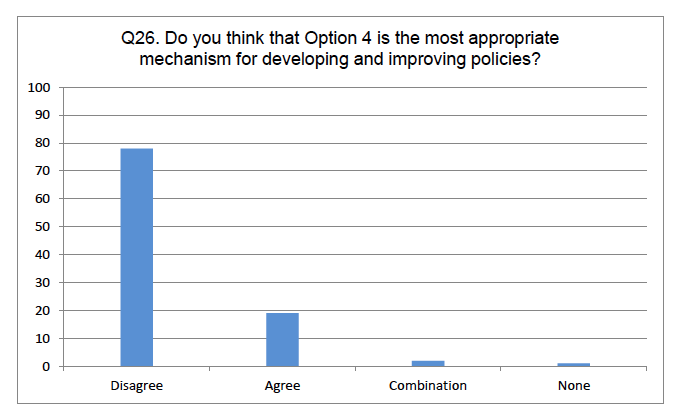Draft Scottish Marine Litter Strategy: Analysis of Consultation Responses
This report presents the analysis of responses to the Scottish Government’s ‘Consultation on a Draft Scottish Marine Litter Strategy'. The consultation closed on 27 September 2013.
Question 26 - Options for Delivery

Figure 3 - Distribution of responses to Question 26
90 respondents commented on the question. 66 (73%) of those who submitted a standard response to Question 26 disagreed and stated a preference for Option 3. Those responses suggested that Option 3 should include the following:
- A lead authority identified;
- Funding for dedicated Policy Officer;
- Funding for high profile campaigns;
- Scotland wide co-ordinated campaigns; and
- Government led data collection strategy, to include baseline data.
Those other respondents (one environmental/conservation organisation, one 'other' organisation and two private individuals) who opted for Option 3 felt that it would allow the marine litter problem to be tackled more successfully, with appropriate funding and resources.
17 (19%) organisations agreed with Option 4, while no individuals stated a preference for this option. The responses from the 17 organisations indicated that Option 4 would be the most appropriate and balanced approach for delivery of the Strategy. Those organisations that said 'yes' to the question comprised four 'other' organisations, three local groups, three public sector organisations, three local authorities, one environmental/conservation organisation, and the fisheries, tourism and energy organisations. A common theme amongst those responses was the need for wide stakeholder and sector engagement, and more specifically, the Strategy should be adapted to local needs. Respondents suggested that Option 4 should include the following:
- Central co-ordination from marine Scotland and a dedicated Policy Officer in context of wider initiatives and international engagement.
- Initiatives that have a direct impact on reducing litter from source.
- Implementation plan, including objectives and performance measures.
- Monitoring plan both for levels of debris in the environment, and the Strategy itself.
- Funding from national, European and international sources.
- Utilise and promote work carried out by existing networks and stakeholders.
- Regular review of resources.
- Networked, regional approach in parallel to regional marine plans to develop and prioritise actions.
One environmental/conservation organisation and one private individual expressed a view that a combination of Option 4 and Option 3, with additional resourcing, would be most effective and prevent unnecessary duplication of effort while prioritising local issues.
One organisation stated that it was not possible to identify a preferred option from the analysis provided in the consultation document, which the respondent felt required further clarity, particularly on cost.
Contact
There is a problem
Thanks for your feedback